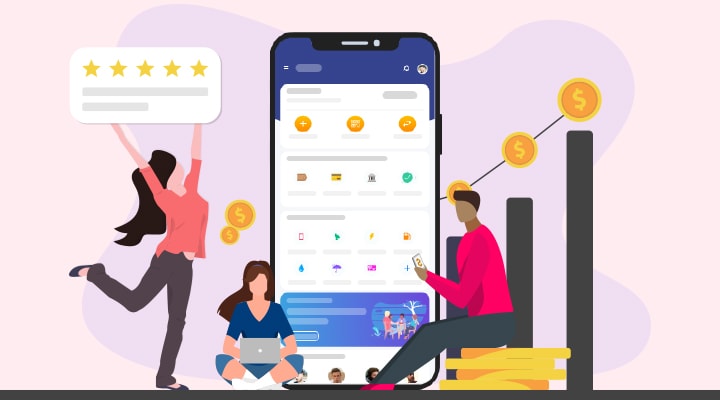The smartphone as a wallet is not a new idea. In 2007 Nokia already launched the first mobile phone with built-in support for NFC (Near Field Communication) technology. This technology is the basis for today’s mobile money solution.
However, if your business has more conservative customers, there are fewer reasons for you to quickly jump into the trend by purchasing a contactless payment terminal in the short term.

Mobile Wallet: Scratch to Advancement
Android Pay: Works for most
Google reacted very quickly to the NFC predictions and created an NFC-based mobile payment solution early with the introduction of the Google Wallet in 2011. However, the service did not catch on, so Google introduced a new payment solution in the spring of 2015, Android Pay.
With the Google Wallet, the user had to open an application to use the payment function. This is no longer necessary with the new Android Pay, which is built into the operating system.
With Android Pay, one simply needs to lock the phone and hold it against the payment terminal. Unlike the other two solutions, Android Pay does not require scanning a fingerprint to authorize the payment. This makes the service slightly faster but also less secure.
Android Pay finds support on many more devices than the competition. Android Pay works with all Android devices with an NFC chip and runs on Android 4.4 KitKat or a newer version. The service is therefore suitable for many types of devices, including those in the lower price categories.
Apple Pay: Secure payment with fingerprint
When it became known that Apple chose to embrace NFC technology as the foundation for their mobile payment solution, many in the payment industry were relieved. With the introduction of Apple Pay, NFC has overcome the last obstacle in becoming the market standard for mobile payments.
Apple Pay works by making it possible for the user to press the Touch ID button and hold the phone against the payment terminal to complete the payment. Apple Pay is supported by the iPhone 6, iPhone 6 plus and the Apple Watch. The service is currently available in the US and the United Kingdom.
Samsung Pay: Mobile payment without NFC
Samsung launched their secure payment solution called ‘Samsung Pay’ in the spring of 2015. Like Apple Pay, the system works through a fingerprint scanner and contact with the payment terminal.
What makes the difference for Samsung Pay compared to the competition is that the service can even be used even if the payment terminal does not support NFC.
This happened due to the technology called Magnetic Secure Transmission (MST), the device can mimic the known payments by means of a magnetic strip. As soon as the device gets close enough to the sensor of a payment terminal, the card reader reads the magnetic signal from the phone as if it were a normal debit card payment. So the service can even be used with older payment terminals.
Samsung Pay can only be used with the two top models; the Samsung Galaxy S6 and the S6 Edge, however, more models will certainly be added over time. The service is currently only available in South Korea and the United States, but Samsung has announced that it is expanding to Europe and China.
Here are some tips to develop a secure mobile wallet
The development of the mobile payment market started very slowly. During the past few years, however, the major players in the mobile market have seriously entered the playing field. Now new mobile payment solutions are constantly being introduced to the market. Before you launch your mobile wallet, take care of these tips to make it powerful and secure:
Protect funds on your card from scammers
An electronic wallet or mobile wallet app must be equipped to make online secure payments using one of the available methods: a terminal, near field communication, credit card, special bank card or using internet banking without giving the bank card details. These are the most secure methods and cannot be hacked by internet scammers.
Convenience of digital payment trends
While the user pays online using a card, the payment gateway asks the card number along with CVV (3 digit code), date of birth and name of the owner. In some cases the user either does not remember one of the details if he does not have the card with him and the transaction does not take place.
But make sure in the case of electronic wallets the user does not have to face this problem and you should not ask a large amount of details but only a 4 or 6 digit passcode to complete the transaction.
Frequent transaction using passcode
Mobile wallets should be developed with another feature of transferring money from one account to another using a passcode. Another feature to be incorporated is between the buyer and seller in which the payment paid by the buyer is only received by the seller when the package or delivery is received.
The seller can see the payment in his account but cannot use it unless the buyer gives him the protection code to unlock the payment. The seller has to use the code with a certain period, otherwise the money is returned to the buyer’s wallet.
Limited risk
In case someone loses their mobile the loss should be less than actually losing a physical wallet. The person who finds the mobile that has an eWallet should not be able to access the bank account by cracking a passcode. At the maximum the owner will lose the money that was in the wallet.
Investing in a contactless terminal
The answer depends on the type of customer you want to attract. If your average customer has ample purchasing power, the latest smart devices and a keen interest in new technology, the demand for the new forms of payment will grow naturally, in parallel with the growing overall support of the services.
If you do plan to purchase your first payment terminal or card reader, or are looking for a replacement for your current system, you would be wise to opt directly for a terminal that can accept contactless payments. Sooner or later, your customers will probably expect to be able to pay mobile.





